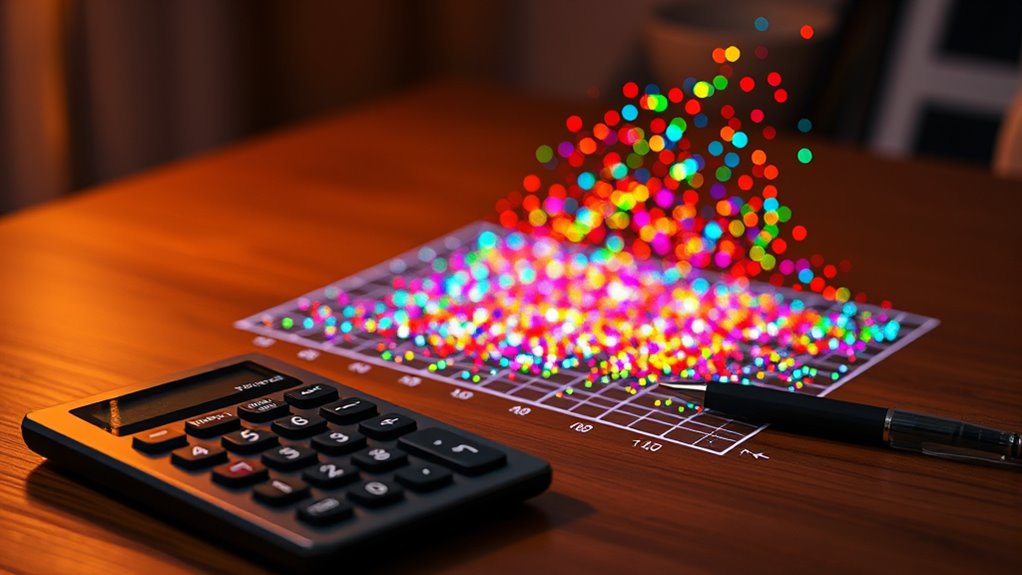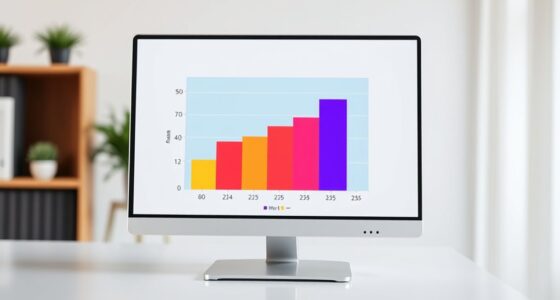Variance and standard deviation both measure how spread out your data is, but they do so differently. Variance calculates the average squared deviations from the mean, which emphasizes larger differences but can be less intuitive. Standard deviation takes the square root of variance, giving you a more understandable, scale-adjusted measure of typical deviations. Outliers can skew both, but data normalization can help. Keep exploring to fully grasp how these tools can clarify your data insights.
Key Takeaways
- Variance measures data dispersion by averaging squared deviations from the mean, emphasizing larger differences.
- Standard deviation is the square root of variance, providing a more intuitive measure in original data units.
- Both metrics are sensitive to outliers, which can inflate the perceived data spread.
- Normalizing data reduces outlier impact, leading to more accurate variance and standard deviation assessments.
- Variance offers a mathematical sense of spread, while standard deviation provides an easily interpretable measure of variability.

Have you ever wondered how statisticians measure the spread of data? Understanding variance and standard deviation is essential because they tell you how much data points differ from the average. When analyzing data, outliers impact your calculations considerably. Outliers are data points that are far removed from the rest of your dataset, and they can skew the results, making your variance and standard deviation appear larger than they truly are. To counter this, data normalization often comes into play. Data normalization adjusts the scale of data points, reducing the influence of outliers. This process helps guarantee that your calculations reflect the typical spread of your data, not just the extremes. Additionally, understanding the diversity of data can help you choose the most appropriate measure of variability for your analysis.
Variance measures how much the data points vary around the mean, providing a squared unit of dispersion. Think of variance as the average of the squared differences between each data point and the mean. Since these differences are squared, variance emphasizes larger deviations, which means outliers impact it heavily. This sensitivity to outliers can sometimes be a drawback because a single extreme value may inflate the variance, giving a misleading picture of your data’s true spread. That’s why understanding the impact of outliers is essential when interpreting variance—it’s highly sensitive to these anomalies.
Standard deviation, on the other hand, is simply the square root of the variance. Because it’s in the same units as your original data, it’s often easier to interpret. For example, if your test scores have a standard deviation of 10 points, you immediately grasp how much scores typically deviate from the average. Like variance, standard deviation is affected by outliers, but since it’s in the original units, it tends to be more intuitive. When outliers impact your data, the standard deviation can be inflated, giving you a distorted sense of variability. To mitigate this, data normalization can help by reducing the influence of extreme values, making your measures of spread more representative of the majority of data points.
Both variance and standard deviation are important tools in statistics, but they serve different purposes. Variance provides a more mathematical, squared perspective of dispersion, while standard deviation offers a more practical, easily interpretable measure. Recognizing how outliers impact these metrics is essential, especially when your data isn’t perfectly clean. In such cases, normalization techniques can help guarantee your calculations truly reflect the typical variation within your dataset, rather than being skewed by anomalies. Whether you’re analyzing test scores, financial data, or scientific measurements, understanding these concepts equips you to interpret variability accurately and make better-informed decisions.
Frequently Asked Questions
How Does Skewness Affect Variance and Standard Deviation?
Skewness effects show how distribution asymmetry influences your data’s spread. When your data is skewed, variance and standard deviation may not fully capture this asymmetry because they focus on overall spread, ignoring shape. High skewness can inflate variance and standard deviation, making your data seem more dispersed than it truly is. Recognizing skewness effects helps you better understand the distribution’s shape and how it impacts these measures.
Can Variance Be Negative in Any Dataset?
Imagine chasing a rainbow, but instead of colors, you seek positive variance. In reality, negative variance doesn’t exist because variance measures the squared distances from the mean, which can’t be negative. If you encounter a negative variance, it’s likely a calculation error or misinterpretation. Variance interpretation always assumes a non-negative number, reflecting the spread of data—never dipping below zero, like a rainbow’s end that’s just out of reach.
Which Is More Useful for Predicting Future Data?
You should focus on standard deviation for predicting future data because it directly measures data spread, aiding in trend analysis. Standard deviation’s intuitive scale helps you assess variability, improving predictive accuracy. While variance offers insights into data dispersion, its squared units are less practical for prediction. Using standard deviation allows you to better understand fluctuations, making it more useful when forecasting future trends and making informed decisions.
How Do Outliers Impact Variance Compared to Standard Deviation?
Outliers considerably impact data variability, influencing variance more strongly than standard deviation. When outliers occur, they increase the squared deviations used in variance calculations, amplifying the effect. Standard deviation, being the square root of variance, also increases but less drastically. Therefore, outlier influence on variance is more pronounced, making it a more sensitive measure for detecting extreme data points and evaluating overall data variability.
Are Variance and Standard Deviation Suitable for Small Sample Sizes?
You might wonder if variance and standard deviation work well with small sample sizes. Due to sample limitations, these measures can be less reliable because they’re sensitive to measurement precision and outliers. Small samples may not accurately reflect the true variability, leading to skewed results. It’s important to interpret them cautiously, as they can overstate or understate variability when data is limited, affecting your overall analysis.
Conclusion
Understanding the difference between variance and standard deviation helps you better interpret data. Did you know that in a recent study, the standard deviation of test scores was only 5 points, indicating most students scored close to the average? This shows how standard deviation provides clear insights into data spread. By grasping these concepts, you’ll be able to analyze information more confidently and make smarter decisions based on the variability within your data.










